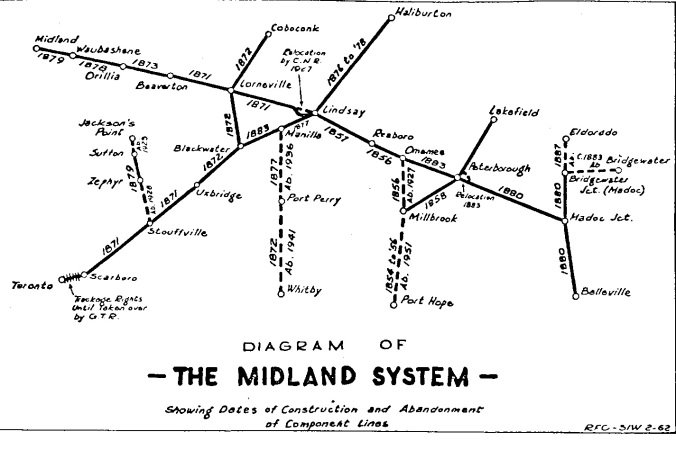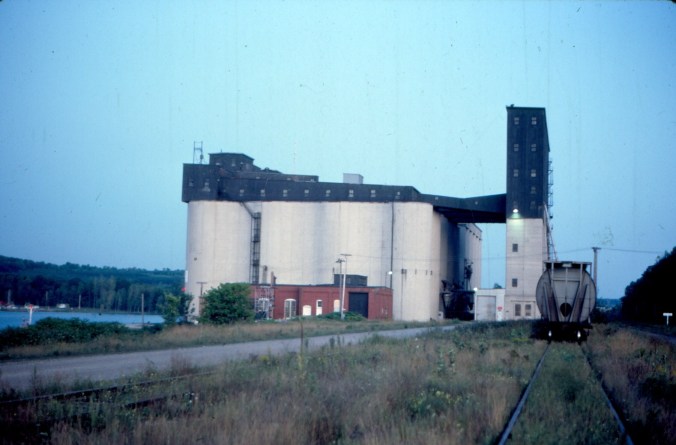
Diagram from the Upper Canada Railway Society’s “Newsletter”, February, 1962.
The Midland Railway of Canada was an amalgamation of several smaller railway lines in Eastern Ontario. Originally chartered as the Port Hope Lindsay and Beaverton Railway, this railway eventually picked up neighbouring railway lines to become the system shown in this diagram in 1883. In 1884, the Grand Trunk Railway of Canada leased the Midland, which became its Midland Division. By 1893 the Midland was fully assimilated within the Grand Trunk (GTR).
One factor driving the GTR’s acquisition of the Midland was the grain traffic developing from a Western Canada opening up to agriculture, the products of which were destined for Eastern Canada, Great Britain and Europe. The introduction of Red Fife wheat to Western Canada increased exponentially the amount of arable land and also the quantity of wheat that could be grown on it. With Toronto, Montreal and other Canadian cities expanding, they provided a ready market for these grains. Britain and Europe were very willing consumers of Canada’s bounty as well. The movement of wheat and other grains resulted in an increase in grain traffic on the railways from the West to what is known as the Lakehead (Fort William and Port Arthur, now known as Thunder Bay) on the west shore of Lake Superior.
An all-rail route for grain to Eastern ports would have resulted in a higher cost to the purchaser for Western Canadian grains. Grain was therefore unloaded from boxcars at the Lakehead, elevated into storage silos in grain elevators, then loaded into lake boats destined to a port on Georgian Bay. There were several Georgian Bay ports competing for this traffic–Owen Sound, Collingwood, Depot Harbour, and Midland. Midland won out over all of these because rail haulage ex Midland offered one of the shortest rail routings to Canadian seaports. The Midland formed a vital role in this routing, making it very attractive to the GTR.
At Midland, grain was unloaded from lake boats into elevators where it was fumigated and stored for shipment onward by rail. The GTR originally had a wood elevator in Midland itself, which burnt in 1905. This was replaced a mile out of town at Tiffin by a steel 900,000-bushel capacity elevator in 1906–the Aberdeen, or Tiffin no. 1. In 1908, the GTR had Tiffin no.2 built by the John Metcalfe Company. With reinforced concrete silos, it originally had a capacity of 2 million bushels. As a bushel of wheat weighs 60 pounds, that’s a lot of grain. CN took over the GTR in 1923, and expanded Tiffin no.2 in the late 1920’s to hold 4,500,000 bushels of grain.

Tiffin no. 2 elevator, 29 August, 1983.
A typical steam-era “Fowler” or “Dominion” steel-frame wood sheathed boxcar holds 1600 bushels of grain. Later steel-framed and steel boxcars held 2,000 bushels worth. (A covered hopper today holds about 3,000 bushels of grain.) The result was often hundreds of carloads shipped weekly out of Tiffin. And almost all of it went through Lindsay.
Canada Steamship Lines erected a million-bushel capacity elevator at Midland later on. Traffic from this elevator generally went via CN, which meant even more grain moving through Lindsay.
“In 1945…51,160,276 bushels of grain loaded at Midland for Montreal and the Atlantic ports of Halifax and St. John rolled through Lindsay”, wrote Charles Heels in his book Railroad Recollections. That’s a lot of grain, a lot of boxcars, and many trains.
With train crews based out of Lindsay, much of the work in that terminal was running grain from Midland via Lindsay to Belleville, or empty cars for loading with grain at Midland from Belleville to Midland. With branchlines running north to Haliburton and southwest to Toronto as well as local traffic, Lindsay was a very busy terminal with upwards of 75 train crew members employed in this town alone. More on Lindsay later…
Many thanks for this history. My family was centred in Lindsay area from 1842 onward. I had no idea of this RR connection.
LikeLike